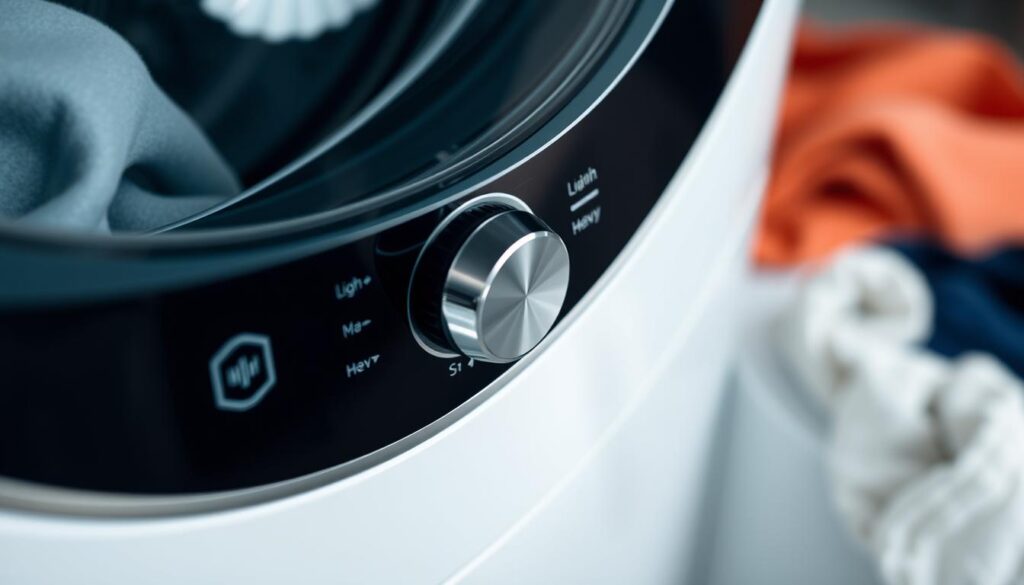What Does Soil Mean on a Washer: Decoding ‘Soil’ on Washing
Understanding soil settings on your washing machine is key for clean clothes and saving energy. “Soil” means how dirty your clothes are. Washing machines adjust their cleaning based on this setting. Knowing about soil settings helps your clothes get clean and your machine work better.

Soil settings let you choose the wash cycle based on how dirty your clothes are. This is important for getting rid of tough stains and keeping delicate fabrics safe. By picking the right setting, you can make your clothes last longer and use less energy.
Introduction to Soil Settings
Soil settings are a vital but often ignored part of washing machines. They greatly affect how well your clothes get cleaned. By learning about soil settings, you can improve your laundry care. This article will explore the importance, benefits, and how to use soil settings with your washing machine.
Key Takeaways
- Soil settings on your washing machine determine the level of cleaning based on the laundry soil level.
- Understanding soil settings is essential for effective laundry care and energy efficiency.
- Soil settings can range from light to heavy, allowing you to customize the wash cycle.
- Selecting the right soil setting can extend the life of your clothes and reduce energy consumption.
- Soil settings are a crucial feature of washing machines that can impact the effectiveness of the wash cycle.
- Using the correct soil setting can help remove tough stains and dirt from your clothes.
Understanding the Basics of Soil Settings
When you do laundry, “soil” means dirt, stains, or debris on clothes. Knowing the soil level definition helps pick the right wash cycle. The right wash cycle settings can remove tough stains and protect your clothes.
The idea of laundry soil is more than just visible stains. It’s also about getting rid of invisible dirt. Choosing the right soil setting ensures your clothes get the cleaning they need. This keeps them looking their best.
Definition of soil level in laundry terms
In laundry, the soil level definition talks about dirt, stains, or debris on clothes. It goes from light soil, like everyday dirt, to heavy soil, with tough stains and debris.
Why washing machines include soil settings
Washing machines have soil settings to tailor the wash cycle for your clothes. The right soil setting gives your clothes the cleaning they need. It also prevents damage.
How soil settings affect wash cycles
The soil setting changes the wash cycle in many ways. For example, heavy soil needs a longer cycle with more water and strong agitation. Light soil gets a shorter cycle with less water and gentle agitation.
Knowing about soil settings and their impact on wash cycles helps you care for your clothes. It ensures they get the cleaning they need to look their best.
| Soil Setting | Wash Cycle Duration | Water Usage | Agitation Intensity |
|---|---|---|---|
| Light Soil | Short | Low | Gentle |
| Medium Soil | Medium | Medium | Medium |
| Heavy Soil | Long | High | Intense |
Different Types of Soil Levels on Modern Washers
Washing machines have three main soil levels: light, normal, and heavy. Knowing the difference helps you clean your clothes better. Light soil is for delicate items like lingerie or towels after a shower.
Heavy soil is for dirty clothes from work or sports. Normal soil works for most everyday laundry. Picking the right soil level is key for a good wash.
- Light soil: delicate or lightly soiled items
- Normal soil: everyday laundry
- Heavy soil: heavily soiled items
Choosing the right soil level ensures your clothes are cleaned well. Whether it’s light, normal, or heavy soil, the right setting makes a big difference.
| Soil Level | Description |
|---|---|
| Light Soil | Delicate or lightly soiled items |
| Normal Soil | Everyday laundry |
| Heavy Soil | Heavily soiled items |
How Your Washer’s Soil Setting Actually Works
Soil detection in washers is key for the wash cycle duration and water use. Knowing how it works helps you use your washing machine better. It uses sensors to find out how dirty the clothes are and changes the cycle.
The dirt level and wash time go hand in hand. Clothes that are really dirty need longer cycles to get clean. This means they use more water. But, some machines use less water by adjusting for different dirt levels.
Choosing the right soil setting is crucial for clean clothes and saving water. It makes sure your clothes are clean and cuts down on water and time. By understanding your washer’s soil setting, you can do laundry better and help the planet.
Choosing the Right Soil Level for Your Laundry
When picking the selecting soil level for your laundry, think about the clothes you’re washing. Laundry soil selection greatly affects how well your clothes are cleaned and how long they last. Start by checking how dirty your clothes are. For instance, office clothes that aren’t very dirty might need a light soil setting. But, sports uniforms that are really dirty might need a stronger wash cycle.
To find the best washing machine settings, consider a few things:
- Type of fabric: Delicates, wool, or silk need a light soil setting. Cotton or linen can handle a bit more.
- Level of soiling: Clothes that are very dirty might need a pre-wash or a stronger wash cycle.
- Desired level of cleanliness: If you want your clothes super clean, choose a higher soil setting.
By picking the right optimal washing machine settings, your clothes will be cleaned well and fast. Always check the care label on your clothes. This makes sure you’re using the right wash cycle and soil setting. With a bit of practice, you’ll get great at selecting soil level and washing your clothes perfectly.
What Does Soil Mean on a Washer Display Panel?
When you look at your washing machine’s control panel, you might see symbols and indicators for different soil levels. These washer display symbols can be confusing. But knowing what they mean is key for managing your laundry well. Symbols like lines, dots, or numbers show how dirty your clothes are.
The soil level indicators help you pick the right wash cycle for your clothes. For example, a high soil level might need a strong wash cycle. But a low level might need a gentler one. Some washers let you choose between manual vs automatic soil selection to fit your needs.
- Light soil: Suitable for clothes with minimal staining or soil
- Normal soil: Suitable for clothes with average staining or soil
- Heavy soil: Suitable for clothes with heavy staining or soil
Understanding these indicators and picking the right soil level helps clean your clothes well and saves time and energy.
| Soil Level | Wash Cycle | Water Usage |
|---|---|---|
| Light | Gentle | Low |
| Normal | Standard | Medium |
| Heavy | Intense | High |
Choosing the right soil level and wash cycle saves time, energy, and water. It also makes your clothes last longer.
The Impact of Soil Settings on Energy Efficiency
Many of us want to make laundry more energy-efficient. The soil setting on our washing machines is key. Choosing the right setting can cut down on power consumption and help the environment. This is crucial for those who care about eco-friendly washing.
Using the correct soil setting can lower water and detergent use. This saves money and reduces our carbon footprint. For instance, washing lightly soiled clothes on a lower setting uses less water and energy than heavily soiled clothes. It’s a simple way to be more energy-efficient and help the planet.

- Using cold water whenever possible
- Line-drying clothes instead of using a dryer
- Choosing a washing machine with a high Energy Star rating
By using these strategies and paying attention to soil settings, we can cut down energy use. This helps make our future more sustainable.
“Every small change we make in our daily lives can add up to make a big difference in the health of our planet. By choosing energy-efficient laundry practices and being mindful of our soil settings, we can all do our part to reduce our environmental impact.”
Common Mistakes When Using Soil Settings
Using the right soil settings on your washing machine is key for clean clothes and saving energy. Yet, many people make laundry mistakes by not knowing how to use these settings right. This can waste water, energy, and make clothes not as clean.
To steer clear of these mistakes, it’s important to know what they are. These include thinking clothes are dirtier than they are, not following the maker’s advice, and washing clothes of different dirtiness levels together. By avoiding these laundry mistakes, you can make your washing machine work better and help the planet.
Understanding Common Errors
Some common errors include:
- Thinking clothes are dirtier than they really are, which wastes water and energy
- Not following the maker’s advice, which can affect how well clothes are cleaned and how long the machine lasts
- Mixing clothes of different dirtiness levels in one wash, which can mess up the cleaning
By following washing machine best practices and avoiding these mistakes, you can make sure your clothes get clean. You’ll also be kinder to your washing machine and the environment. Remember, picking the right soil setting is crucial for the best results and avoiding incorrect soil settings that waste resources.
Knowing these common mistakes and how to avoid them can greatly improve your laundry routine. Always check your washing machine’s manual for tips on washing machine best practices. It will help you use soil settings correctly and avoid laundry mistakes.
| Soil Level | Recommended Use |
|---|---|
| Light | Delicates, lightly soiled items |
| Normal | Regularly soiled items, everyday laundry |
| Heavy | Heavily soiled items, bulky or heavily stained laundry |
Best Practices for Heavy Soil Settings
When washing clothes with heavy soil, use the maximum soil setting on your washing machine. This setting is perfect for clothes with tough stains or bad smells. Before washing, treat any stains you see. Also, adjust the water temperature and detergent amount as the manufacturer suggests.
Here are some tips for using the heavy soil setting effectively:
- Sort clothes before washing to separate heavily soiled items from lighter ones
- Use the right amount of detergent to avoid over-sudsing, which can reduce the washing machine’s efficiency
- Check the care labels on your clothes to ensure you’re using the right water temperature and wash cycle
Using the heavy soil setting might make the wash cycle longer. But it’s worth it for clean clothes. By following these tips, your heavily soiled clothes will look and feel great.
Always follow the manufacturer’s guidelines for the heavy soil setting. Don’t use it for clothes that aren’t really dirty. Being smart about washing habits can make your clothes and washing machine last longer. It also saves energy and water.
| Soil Setting | Water Temperature | Detergent Amount |
|---|---|---|
| Heavy Soil | Hot | Maximum |
| Normal Soil | Warm | Medium |
| Light Soil | Cold | Minimum |
Light Soil Settings and When to Use Them
Many of us use heavy soil settings for laundry, thinking our clothes need a tough wash. But, this isn’t always true. Using the light soil setting can be a smart choice for lightly worn clothes and delicate items. It saves energy and water too.
The minimal soil setting is ideal for items that don’t need a deep clean. Think towels, t-shirts, and everyday clothes. This setting uses less water and detergent, making it better for the planet. Plus, quick wash cycles help your clothes last longer.

- Washing delicate items, such as lingerie or silk clothes
- Refreshing lightly worn clothes, such as t-shirts or socks
- Washing towels or other household items that don’t require a deep clean
Using the light soil setting in these cases helps your clothes last longer. It also reduces your environmental impact and saves time and energy.
In summary, the light soil setting is perfect for an eco-friendly laundry routine. It uses minimal soil settings and quick wash cycles. This way, you keep your clothes looking great while helping the environment.
Troubleshooting Soil Level Problems
Laundry troubles often include issues with soil levels. Clothes might not get clean enough, or your washing machine could have soil sensing problems. You can fix these issues with some troubleshooting steps. This can save you time and money.
When clothes don’t clean up right, it might not be the soil setting’s fault. It could be wrong detergent or a broken washing machine. Always check the manual or call a pro for washing machine repair.
Identifying and Addressing Soil Sensing Issues
To tackle soil sensing problems, first look at the washing machine’s sensors. Check for blockages or damage. Regular upkeep can avoid these problems. If issues continue, a pro for washing machine repair might be needed.
When to Contact Professional Repair
Some problems need a pro’s touch for washing machine repair. If DIY fixes don’t work, or if soil sensing problems keep happening, get help. A professional can fix the issue and get your laundry back on track.
Special Considerations for Different Fabric Types
Understanding the needs of different fabrics is key when it comes to fabric-specific laundry. This is where soil settings for delicates play a role. They allow for a gentler cleaning process. Adjusting the soil settings on your washing machine ensures delicate items get the care they need.
Silk and wool need a different cleaning approach than cotton or polyester. The right washing machine fabric care settings can prevent damage and extend garment life. Here are some tips to keep in mind:
- Always check the care label on your garment to determine the recommended washing method.
- Use a gentle cycle with cold water for delicate items.
- Avoid using harsh detergents or bleach, as they can damage certain fabrics.
By understanding the specific needs of your fabrics and adjusting your soil settings accordingly, you can keep your clothes looking their best. Remember, fabric-specific laundry is about finding the right balance between cleaning and care.
Conclusion: Making the Most of Your Washer’s Soil Settings
Understanding your washing machine’s soil settings is key. It makes a big difference in how well your clothes get cleaned. By choosing the right soil level, you save water and energy too.
Whether you have a high-efficiency front-loader or a traditional top-loader, knowing your machine’s settings is important. It helps you get the best results for all kinds of laundry. From tough stains to delicate fabrics, the right soil setting makes a big difference.
Next time you do laundry, use what you’ve learned. Make the most of your washer’s soil settings for clean, fresh clothes. Your wallet and your clothes will appreciate it.
FAQ
What is the definition of “soil level” in laundry terms?
In laundry terms, “soil level” means how dirty clothes are. It shows how much dirt or grime is on them.
Why do washing machines include soil settings?
Washing machines have soil settings to help users wash clothes right. It saves water and energy by adjusting the wash cycle.
How do soil settings affect the wash cycle?
Soil settings change the wash cycle in many ways. For example, more soiled clothes need longer washes and more water. This makes sure clothes get really clean.
What are the common soil level options on modern washing machines?
Modern washing machines usually have light, normal, and heavy soil settings. Some may have more options or different names for these.
How do washing machines detect the soil level?
Washing machines use sensors or pre-set cycles to figure out soil levels. This helps them clean clothes right.
How does the wash time relate to the chosen soil level?
Wash time and soil level are directly linked. Heavier soiled clothes need longer washes. Lighter clothes wash faster.
How does water usage vary across different soil settings?
Water use goes up with soil level. Heavily soiled clothes need more water to clean well. Lightly soiled clothes use less.
How can I assess the soil level of my laundry and select the appropriate setting?
Look at how dirty your clothes are to pick the right setting. Office clothes might need light, but sports uniforms need heavy.
What do the common symbols and indicators for soil levels mean on my washer’s display panel?
Symbols on your washer show soil levels. For example, one dot means light, and three dots mean heavy.
How can soil settings impact the energy efficiency of my washing machine?
Choosing the right soil setting saves energy. It uses less water and time, which saves money and energy.
What are some common mistakes people make when using soil settings?
People often pick the wrong soil level or mix dirty and clean clothes. This can waste resources and damage clothes.
When should I use the heavy soil setting on my washing machine?
Use heavy soil for very dirty clothes like work uniforms. Always treat stains first and use the right detergent.
What are the benefits of using the light soil settings on my washing machine?
Light soil settings are good for lightly worn clothes and saving energy. They use less water and time, and are gentler on clothes.
How can I troubleshoot issues related to soil level settings on my washing machine?
If clothes aren’t clean, check the soil sensing or detergent amount. If problems continue, call a repair service.
How should I adjust soil settings for different fabric types?
Choose soil settings based on fabric type. Delicate fabrics need light, while tough ones need heavy.

